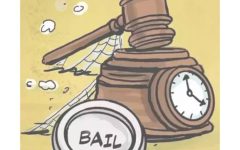Bombay High Court Orders Immediate Release of 17-Year-Old in Fatal Porsche Accident, Emphasizes Juvenile Justice Principles
June 25, 2024 2024-07-05 17:05Bombay High Court Orders Immediate Release of 17-Year-Old in Fatal Porsche Accident, Emphasizes Juvenile Justice Principles

Bombay High Court Orders Immediate Release of 17-Year-Old in Fatal Porsche Accident, Emphasizes Juvenile Justice Principles
By Shazia Siddiqui
In a significant ruling, the Bombay High Court ordered the release of a 17-year-old boy involved in a tragic Porsche car accident in Pune. This decision overruled the previous directive by the Juvenile Justice Board (JJB), which had remanded the minor to an observation home following the incident that claimed the lives of two individuals on May 19.
The case began in the early hours of May 19, when the teen, allegedly intoxicated and driving a luxury car, collided with a two-wheeler, resulting in the deaths of two tech professionals. The immediate reaction from the authorities was to grant the boy bail the same day, allowing him to be under the supervision of his parents and grandfather. However, under intense public and media scrutiny, the police quickly sought a revision of this bail order. On May 22, responding to the application, the JJB reversed its decision and ordered the boy’s detention in an observation home, leading to his placement there.
The boy’s paternal aunt subsequently filed a plea challenging the JJB’s decision, arguing that his detention was unlawful and heavily influenced by external factors rather than being based on the principles of juvenile justice. This plea was brought before the Bombay High Court, which then scrutinized the case to determine the legality of the JJB’s orders and the treatment of the boy under the Juvenile Justice (Care and Protection of Children) Act.
In its deliberations, the High Court found that the JJB had acted beyond its jurisdiction in ordering the boy’s detention without considering his age. The court underscored that the minor, being under 18, should be treated as a “Child in Conflict with Law” (CCL), in accordance with the Juvenile Justice Act. This act mandates that juveniles, irrespective of the severity of their alleged crimes, be handled with a focus on rehabilitation rather than punishment, ensuring they receive treatment separate from adult offenders.
The High Court criticized the JJB’s hasty decision, which appeared to be a reaction to the immediate public and media uproar following the accident. The court pointed out that such reactions often overlook the nuanced requirements of juvenile justice, particularly the necessity to consider the age and specific circumstances of minors. The ruling emphasized that despite the public’s emotional response and demand for swift justice, the legal system must adhere strictly to the protections and rehabilitative aims outlined in the Juvenile Justice Act.
Furthermore, the court noted that the boy was already undergoing a process of rehabilitation, which is central to the Juvenile Justice system’s objectives. The minor had been referred to a psychologist, and the court highlighted that this rehabilitative process should continue, underscoring the importance of treating juveniles in a manner that promotes their reintegration into society. The court’s decision to release the boy into the custody of his paternal aunt was aligned with this philosophy, ensuring that he remains in a supportive environment conducive to his ongoing rehabilitation.
This ruling by the Bombay High Court is a reaffirmation of the principles enshrined in the Juvenile Justice Act. It serves as a reminder that the justice system’s response to juveniles must be tempered with a focus on their rehabilitation and reintegration, rather than purely punitive measures. The court’s decision highlights the need to shield judicial processes from external pressures and public sentiment, particularly in cases involving minors, to uphold the integrity and intended protections of juvenile justice legislation.
Thus, the High Court’s ruling underscores the judiciary’s commitment to ensuring that minors are treated with the care and consideration mandated by law, reflecting the core objective of the Juvenile Justice system to rehabilitate rather than punish young offenders.









